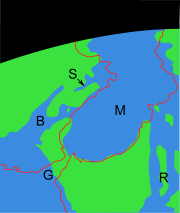
Sorbas basin
Encyclopedia

Sedimentary basin
The term sedimentary basin is used to refer to any geographical feature exhibiting subsidence and consequent infilling by sedimentation. As the sediments are buried, they are subjected to increasing pressure and begin the process of lithification...
around the town of Sorbas
Sorbas
-External links: - The Sorbas Website - Sistema de Información Multiterritorial de Andalucía - Diputación Provincial de Almería - Description, information and photographs of Sorbas, Almeria. In English & Spanish*...
in south-east Spain. It is believed to have been formed by extension, between two fault-bounded blocks which rotated anti-clockwise to take up the compression resulting from Europe's collision
Orogeny
Orogeny refers to forces and events leading to a severe structural deformation of the Earth's crust due to the engagement of tectonic plates. Response to such engagement results in the formation of long tracts of highly deformed rock called orogens or orogenic belts...
with Africa. The basin is filled with turbidite
Turbidite
Turbidite geological formations have their origins in turbidity current deposits, which are deposits from a form of underwater avalanche that are responsible for distributing vast amounts of clastic sediment into the deep ocean.-The ideal turbidite sequence:...
s and evaporite
Evaporite
Evaporite is a name for a water-soluble mineral sediment that result from concentration and crystallization by evaporation from an aqueous solution. There are two types of evaporate deposits, marine which can also be described as ocean deposits, and non-marine which are found in standing bodies of...
s of the Tortonian
Tortonian
The Tortonian is in the geologic timescale an age or stage of the late Miocene that spans the time between 11.608 ± 0.005 Ma and 7.246 ± 0.005 Ma . It follows the Serravallian and is followed by the Messinian....
-Messinian
Messinian
The Messinian is in the geologic timescale the last age or uppermost stage of the Miocene. It spans the time between 7.246 ± 0.005 Ma and 5.332 ± 0.005 Ma...
ages of the Miocene
Miocene
The Miocene is a geological epoch of the Neogene Period and extends from about . The Miocene was named by Sir Charles Lyell. Its name comes from the Greek words and and means "less recent" because it has 18% fewer modern sea invertebrates than the Pliocene. The Miocene follows the Oligocene...
Epoch
Epoch (geology)
An epoch is a subdivision of the geologic timescale based on rock layering. In order, the higher subdivisions are periods, eras and eons. We are currently living in the Holocene epoch...
.
It is a matter of some debate whether the basin dried out at the same time as the main Mediterranean basin
Mediterranean Basin
In biogeography, the Mediterranean Basin refers to the lands around the Mediterranean Sea that have a Mediterranean climate, with mild, rainy winters and hot, dry summers, which supports characteristic Mediterranean forests, woodlands, and scrub vegetation...
s.
Basin fill
The basin is divided into the following members:- At the bottom of the image, the house is constructed on the steep yellow cliffs of the resistant Azagador member.
- The lower (whiter) and upper (yellower) Abad marls, a Tortonian/MessinianMessinianThe Messinian is in the geologic timescale the last age or uppermost stage of the Miocene. It spans the time between 7.246 ± 0.005 Ma and 5.332 ± 0.005 Ma...
series of turbiditeTurbiditeTurbidite geological formations have their origins in turbidity current deposits, which are deposits from a form of underwater avalanche that are responsible for distributing vast amounts of clastic sediment into the deep ocean.-The ideal turbidite sequence:...
s featuring pronounced Milankovic (20,000 year precession) cyclicity, allowing chronostratigraphic datingChronostratigraphyChronostratigraphy is the branch of stratigraphy that studies the age of rock strata in relation to time.The ultimate aim of chronostratigraphy is to arrange the sequence of deposition and the time of deposition of all rocks within a geological region, and eventually, the entire geologic record of...
; these fine muds are easily eroded. - When the sea returned overdeepening the basin, salt water waterfalls eroded a 200 m depression patterned by 30 m deep gullies.
- the Messinian Yesares member, a gypsumGypsumGypsum is a very soft sulfate mineral composed of calcium sulfate dihydrate, with the chemical formula CaSO4·2H2O. It is found in alabaster, a decorative stone used in Ancient Egypt. It is the second softest mineral on the Mohs Hardness Scale...
evaporite, forms the steep bluffs at the top of the valley; there is some debate about how conformable its contact with the Abad marls is. - PliocenePlioceneThe Pliocene Epoch is the period in the geologic timescale that extends from 5.332 million to 2.588 million years before present. It is the second and youngest epoch of the Neogene Period in the Cenozoic Era. The Pliocene follows the Miocene Epoch and is followed by the Pleistocene Epoch...
deposits, rest unconformablyUnconformityAn unconformity is a buried erosion surface separating two rock masses or strata of different ages, indicating that sediment deposition was not continuous. In general, the older layer was exposed to erosion for an interval of time before deposition of the younger, but the term is used to describe...
on the top. - Complexity of drawdown and reflooding complicate correlation of the ‘Salinity Crisis' stratigraphy.
Basin significance

The basin was separated from the main Mediterranean basin during the Messinian salinity crisis
Messinian salinity crisis
The Messinian Salinity Crisis, also referred to as the Messinian Event, and in its latest stage as the Lago Mare event, was a geological event during which the Mediterranean Sea went into a cycle of partly or nearly complete desiccation throughout the latter part of the Messinian age of the Miocene...
; therefore the timing of the Yesares member relative to the main basin evaporites is crucial to distinguish between models of how the Mediterranean dried out.

